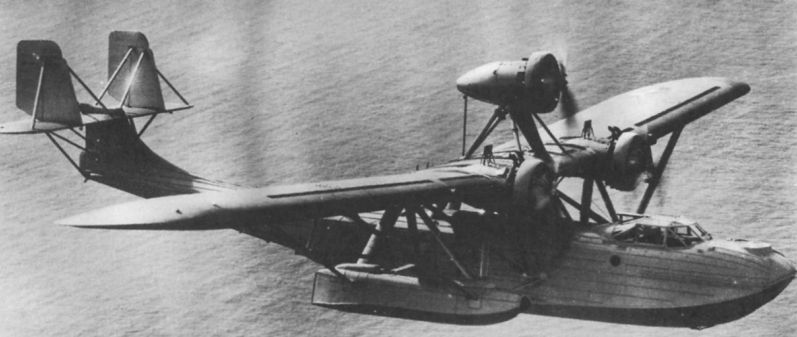Martin XP2M и P3M
Работы по совершенствованию патрульной летающей лодки Curtiss Model 6 проводил в британских ВМС на авиастанции Феликстоу, Саффолк, скуадрон-коммандер Порти. Подобные работы по аналогичному варианту F-5 также велись в годы войны на заводе "Curtiss" и после войны на авиационном заводе ВМС США под обозначением NAF PN. В середине 1920-х годов разработка продолжилась в Бюро по Аэронавтике ВМС, выпуск прототипа XPY-1 был заказан компании "Consolidated" в феврале 1928 года (Consolidated P2Y). После успешных летных испытаний ВМС США объявили тендер на дальнейшую разработку и производство самолета. Конкурс выиграла компания "Martin", построившая трехмоторный прототип XP2M-1 позже перестроенный в двухмоторный XP2M-2. Затем "Martin" построила девять самолетов, близких двухмоторному прототипу, включая три P3M-1 с двумя моторами Pratt & Whitney R-1340-48 Wasp мощностью по 430 л. с. и шесть P3M-2 с моторами Pratt & Whitney R-1690-32 Hornet мощностью по 525 л.с. и закрытой кабиной летчика. Самолеты использовались, главным образом, в качестве учебных и транспортных.
Показать полностьюShow all
Flight, March 1934
The Martin 121 Flying Boat
UNUSUAL, in that it may be used as either a twin-engined or triple-engined type, the Martin 121, or, as it is known in the U.S. Navy, the XP2M-1, is one of the largest flying boats developed for the U.S. Navy. It is intended primarily for long-distance patrol use, but is convertible for duty as a bomber.
The aircraft is an externally-braced high-wing monoplane, the wing consisting of a centre section and two outboard sections. Structurally, the wing is composed of two riveted truss type spars of aluminium alloy, aluminium alloy channel section ribs, double drag bracing and fabric covering. Balanced ailerons are fitted. One of the highly successful features of the aircraft is the use of the two outboard floats, which are of riveted aluminium alloy construction, as the main fuel containers. These are carried by the wing-bracing structure. With two auxiliary fuel tanks in the centre section the entire hull is kept open for the use of the crew, the space normally occupied by fuel tanks being so utilised.
Riveted aluminium alloy construction is used for the hull, which has a deep Vee bottom and two steps. The main vertical fin supporting the tail surfaces is built integral with the hull. There are five compartments in the hull separated by watertight bulkheads fitted with large watertight doors. The tail unit is of the monoplane type with twin fins and rudders carried on the main fin which is built integral with the hull.
The tail plane is adjustable through 6 deg. and the rudders are fitted with trailing edge "tabs" adjustable from the pilot's cockpit. All moving parts have external lubrication fittings.
Either two or three 575-h.p. Wright "Cyclone" geared radial air-cooled engines driving metal tractor airscrews are fitted. The nacelles are mounted in the leading edge of the centre section and, in the case of the three-engined type the centre engine nacelle is carried on struts above the wing. Electric inertia starters are operated from the mechanic's control panel.
Normally the crew consists of pilot, assistant pilot, wireless operator and two gunner-mechanics. An enclosed cabin is provided for the pilots, and bunks and living accommodation are arranged within the hull.
MARTIN 121
Dimensions
Span 100 ft. (30,5 m).
Length 61 ft. 2 1/2 in. (18,66 m).
Height (three engines) 20 ft. 9 in. (6,32 m).
,, (two engines) 15 ft. 10 in. (4,82 m).
Wing area 1,204-2 sq. ft. (111,87 m2).
As a Three-engined Type
Weight empty 12,700 lb. (5 761 kg).
Normal patrol weight, loaded 20,175 lb. (9 151 kg).
Overload patrol weight, loaded 23,150 lb. (10 501 kg).
Normal wing loading 16-75 lb./sq.ft. (81,78 kg/m2).
,, power loading 11-70 lb./h.p. (5,31 kg/h.p.).
Maximum speed 143 m.p.h. (230,1 km/h.).
Landing speed 67 m.p.h. (107,8 km/h.).
Climb in 10 minutes 6,600 ft. (2 012 m).
Service ceiling 14,600 ft. (4 450 m).
As a Twin-engined Type
Weight empty 10,115 lb. (4 580 kg).
Patrol weight, loaded 18,435 lb. (8 380 kg).
Wing loading 15-3 lb./sq. ft. (74,7 kg/m').
Power loading 16-0 lb./h.p. (7,26 kg/h.p.).
Maximum speed 127-5 m.p.h. (205 km/h.).
Landing speed 64 m.p.h. (103 km/h.).
Climb in 10 minutes 4,420 ft. (1 480 m).
Service ceiling 10,800 ft. (3 290 m).
Range at cruising speed 1,900 miles (3 060 km).
Показать полностьюShow all





